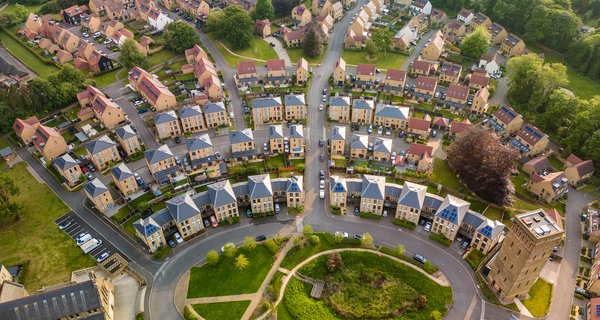Assumptions and methods
Installation costs
The costs of heat pumps used in this report are derived from data from the Microgeneration Certification Scheme (MCS) Installations Database.
- We used data from MCS-certified air-source heat pump installations into properties in England, Scotland, and Wales (between January 2021 to mid-2023) where we could match an Energy Performance Certificate (EPC) [8].
- Costs have been adjusted for inflation to the 2023 equivalent using the Consumer Price Index.
- Costs include the unit price, materials and labour for installation, and may include any associated necessary upgrades to heating systems (such as hot water tanks, new radiators, pipework), including VAT [9]. They do not include any simultaneous insulation works.
- Median costs for some of the archetypes are approximately: £9,700 for flats, £12,000 for semi-detached and terraced houses, and £14,000 for detached houses.
Future heat pump prices depend on how demand changes and how the market develops. We consider two options for price development – a baseline option with a stable annual price decrease of 2.5% and an optimistic option with a 4.5% annual reduction (corresponding to a drop by 26% and 42% in 2035 from 2023, respectively). These match the ‘optimistic’ and ‘moderate’ scenarios we developed using experience and learning rates in our previous work. This means that in the baseline scenario the price of a heat pump for an average home goes down to about £10,000 by 2030.
We assumed flat installation prices for gas boilers for the next 10 years: £1,550 for flats, £1,860 for medium-sized homes, and £2,270 for detached houses. These estimates are based on BEIS (2017), Delta-ee for BEIS (2018), and our own market research and adjusted to 2023 prices using Consumer Price Inflation index 05.3.
The analysis is conducted in 2023 prices, which means that future inflation is not taken into account, apart from on energy prices.
Subsidies
The actual upfront costs of a heat pump that fall on households are hugely influenced by the level of governmental subsidies. We consider two options:
- Subsidies are reduced gradually until 2033
- Subsidies are reduced several times, but stay relatively high at £3,000 throughout – until 2035.
In both options we assume the current grant scheme (BUS) to remain at £7,500 until 2028 as planned. Our model does not account for the effect that the level of subsidy can have on uptake when estimating future costs of subsidising heat pumps. We also assume that all households who install a heat pump use the subsidy available.
Finance
Even with subsidies, the remaining upfront cost required is still a significant burden for most households. We expect that homeowners will use finance to purchase a heat pump in the future. Defining a market interest rate for heat pump finance is difficult, and is also a potential area where governments can take policy action. The March 2024 OBR forecast has the long-term Bank of England interest rate at 3.2%, so we have used a flat rate of 5% for all heat pump purchases to represent a small mark-up over this rate. In reality, this rate could be much higher (especially if heat pumps are seen as a high-risk investment) or lower with government policy action.
Running costs
Annual running costs for heating are determined by the unit prices of electricity and gas and energy demand.
Energy prices
After the peak of the energy crisis, the price of electricity has come down in both absolute terms and relatively compared to gas, but it is still about 4.1x higher per unit than gas. Consumer prices of electricity and gas have several components including: the wholesale price of energy, network and operating costs, and additional policy-specific levies. These policy costs currently account for 17% of the unit price for electricity, but only 6% of the gas price. Our model uses wholesale electricity and gas price projections by DESNZ (Figure 16), keeping prices constant after 2031 [10]. DESNZ expects electricity prices to fall more sharply than gas in the next five years, which would narrow the price gap. However, energy price forecasts are extremely uncertain, especially since the 2022 energy crisis, so there is significant scope for error here. In our scenarios we use two options for the wholesale electricity price (reference option and low-price option) in conjunction with varying future green levies.

Wholesale energy price projections used in our model
Figure 16
This line graph shows the projections used in the model for wholesale energy prices between 2025 and 2050. Three lines represent two different projections for electricity (reference used in Scenarios 1 and 3 and low used in Scenario 2) and one reference projection for gas. The reference and low electricity prices start around 10 and 7 p/kWh, respectively. They decrease gradually to 4.4 and 3.7 p/kWh in 2030. Gas prices remain relatively flat, from 3.9 to 2.5 p/kWh. The model indicates with a dotted line that we have replaced DESNZ projections with flat prices from 2031 onward.
We consider two options for changing electricity and gas levies, assuming that any changes are put in place from 2026 onwards:
- Levies are rebalanced to equalise per-unit costs on both electricity and gas while keeping the total levies paid by a typical consumer constant.
- Levies are rebalanced to make the total amount paid through gas and electricity by the typical consumer equal.
For the purposes of this analysis, we assume that households switching to a heat pump will disconnect from the gas grid and stop paying a standing charge for gas.
- Our model does not consider the additional costs of switching from gas to induction hobs for cooking.
- Our model does not consider any per-household costs of disconnecting from the gas grid.
- We do not include any annual increase in levies or other costs (network, operating costs); our analysis uses the April–June 2024 levels at a flat level until 2050.
- We keep gas standing charges constant at current levels. It is likely that these will increase in future, particularly if the number of properties using gas is reduced.
Energy demand
Heat demand for each home archetype is derived from heat demand estimates in the MCS Installations Database. This covers properties in England, Scotland, and Wales that had an MCS-certified installation of an air-source heat pump between January 2021 and mid-2023 and that we could match an EPC record to. Heat demand is largely determined by the age of a property (older properties having lower thermal efficiency) and then also its size (larger properties require more energy). Heat demand levels for some of our archetypes are: 5,800 kWh for flats, 11,600 kWh for semi-detached and terraced houses, and 18,300 kWh for detached houses.
We assume that heat pumps have a coefficient of performance of 3 (baseline) which can increase over time to 3.3 (optimistic scenario). Gas boiler efficiency is set to 0.85. This means that gas boilers use approximately more than 3.5x more energy to produce one unit of heat (baseline).
We assume in this model a home with a heat pump will require the same amount of heat as one with a gas boiler. There is some evidence to suggest that some heat pump users may have higher heat demand relative to gas boiler users, because heat pumps work more effectively when running constantly. However, we have used the same heat demand for both heat pumps and gas boilers here as: i) there is limited real-world evidence on this effect at this stage; and ii) there is a risk that our analysis would no longer be a like-for-like comparison because heat pump users are using more heat.
Other assumptions and methodology notes
- We focus here on the relative costs of air-source heat pumps as they are the most common low-carbon solution. We expect shared ground loops, heat networks and other technologies will need to hit similar cost levels to be competitive.
- Our analysis hasn't factored in the impact of time of use tariffs, nor of combining home solar panels or batteries with heat pumps. This has scope to reduce running costs for heat pumps significantly, but is hard to predict.
- Running costs also include total maintenance costs over 15 years – £750 for a heat pump and £1,200 for a gas boiler. Different maintenance costs could quite significantly affect price parity.
--------------------
[8] The combined dataset used for the analysis consists of information from over 50,000 installations.
[9] We have previously described what determines the cost of a heat pump in more detail in ‘How to reduce the cost of heat pumps’, 2022.
[10] DESNZ: Energy and emissions projections: 2022 to 2040








